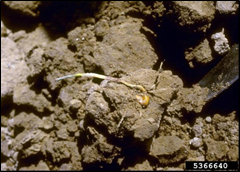Seedling Blights in Corn
Seedling Blights
Symptoms
Pre-emergence symptoms often include a soft rot of stem tissue and discoloration of affected areas ranging from

Pythium diseases (Pythium spp.) on corn
whitish-gray to pink, to dark brown or black. Seeds may rot before or after germination. (Infected seedling is on the right in this photo.) Post-emergence symptoms are yellowing, wilting and death of leaves.
Examine plant roots thoroughly to rule out the possibility of insect injury from rootworm or cutworm. Root symptoms of seedling blights include rotting of the roots, which may appear brown, watersoaked, faintly pink or greenish-blue. This can result in an uneven stand height later in the season.
Cause
Seedling blights are caused by common fungi found in Kentucky soils. Pythium, Stenocarpella (=Diplodia), and Fusarium are the three fungi most often associated with seedling blight in Kentucky. Look for seedling blight in poorly drained, compacted, or cold, wet soils. The disease usually does not limit stands, but can do so when seedlings are stressed.
Chemical injury may show similar symptoms to seeding blight, but damage usually follows closely the patterns of application and this is especially evident at the turn rows. True seedling blights, on the other hand, are usually scattered with no regular pattern other than an association with low, wet areas.
IPM Techniques
- Corn plants should be checked for seedling blights soon after emergence and two more times at two-week intervals.
- Observe two rows of plants 10 feet in length at scouting sites. The number of random sites you should observe when scouting a field is based on the size of the field. To determine the number of scouting sites see Scouting Corn.
- Report the severity of the disease according to the following rating scale:
0 = no seedling blight observed
1 = 1-4% of plants affected
2 = 5-20% of plants affected
3 = 21-100% of plants affected
- Plant seeds in moist soils when soil temperature at 2 inch depth measured after sunrise exceeds 50 degrees F.
- Place herbicide, fertilizer, insecticide and seed properly to avoid stress and injury to seedlings.
- Use injury-free, high quality seed and use good cultural practices to decrease the likelihood of seedling diseases.
- Seed-protection fungicides can also decrease fungal disease occurrence.
References and Additional Information
- IPM-2 Kentucky IPM Manual for Corn
- PPA-10a Kentucky Plant Disease Management Guide for Corn and Sorghum by P. Vincelli and D.E. Hershman, Extension Plant Pathologists, University of Kentucky
Compendium of Corn Diseases. M.C. Shurtleff. The Amer. Phytopathol. Soc. 1980


